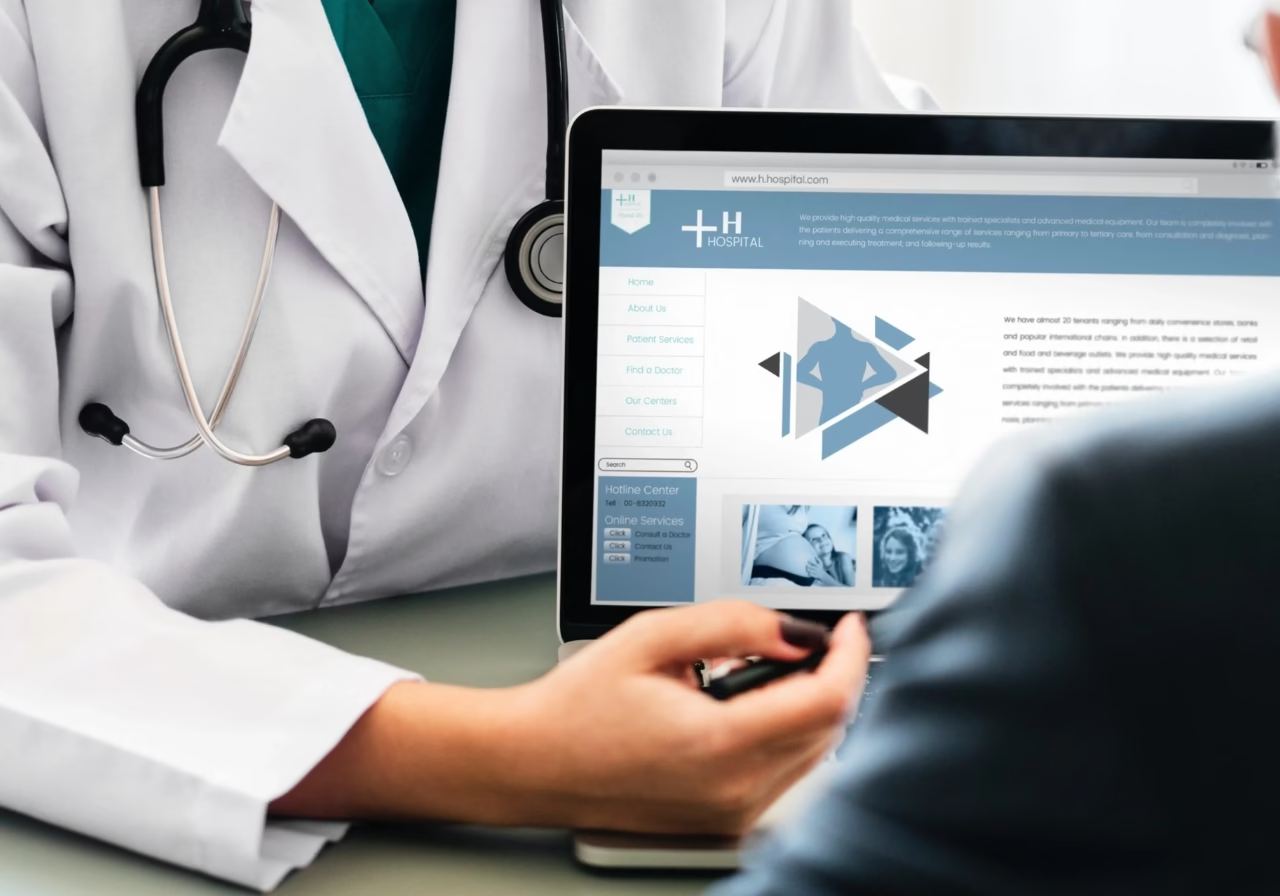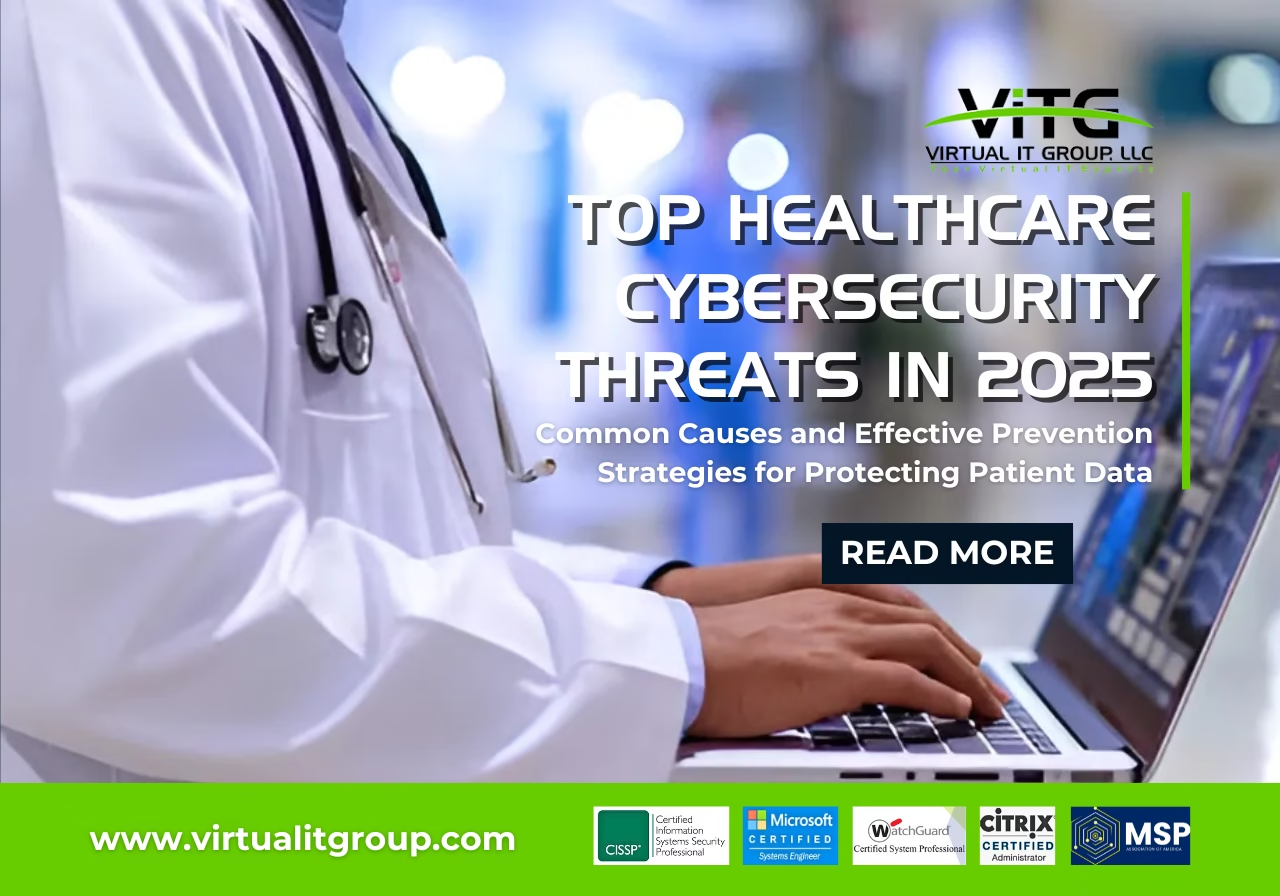Healthcare cybersecurity threats are a growing concern for organizations in the healthcare sector, particularly as they continue to adopt digital tools, telemedicine, and electronic health records (EHRs). In 2025, these threats are becoming more sophisticated and widespread, posing significant risks to patient data, healthcare operations, and financial stability. From ransomware attacks to insider threats, healthcare organizations are under constant attack from cybercriminals who aim to steal sensitive information or disrupt operations.
As healthcare providers in Tampa Bay and across the nation face these mounting challenges, it’s essential for them to adopt robust cybersecurity strategies to safeguard their systems, protect patient information, and ensure business continuity. In this article, we will outline the most common healthcare cybersecurity threats in 2025, explore their causes, and provide actionable strategies to mitigate these risks and protect sensitive data.
Table of Contents
- Introduction to Healthcare Cybersecurity Threats
- Ransomware Attacks: The Rising Threat in Healthcare
- Phishing and Social Engineering: Common Tactics for Data Theft
- Data Breaches and Unauthorized Access: Protecting Sensitive Information
- Medical Device Vulnerabilities: Securing Connected Healthcare Systems
- Insider Threats: The Risks from Employees and Contractors
- Supply Chain Attacks: Targeting Third-Party Vendors
- Third-Party Risks: Managing External Vendor Security
- Telemedicine and Remote Care Security: The New Frontier
- How ViTG Helps Prevent Healthcare Cybersecurity Threats
- 24/7 Security Monitoring
- Cybersecurity Expertise
- Rapid Incident Response and Remediation
- Proactive Vulnerability Management
- Data Encryption
- Secure Network Infrastructure
- Security Awareness Training
- Regular Data Backups and Disaster Recovery Planning
- Conclusion
- Frequently Asked Questions (FAQs)

Top Healthcare Cybersecurity Threats in 2025: Common Causes and Effective Prevention Strategies for Protecting Patient Data
Understanding the Growing Healthcare Cybersecurity Threats
Healthcare organizations handle vast amounts of sensitive data, including personal health records, financial information, and medical research data. This makes them a prime target for cybercriminals. The consequences of a cybersecurity breach in healthcare are severe, ranging from financial losses and reputational damage to legal liabilities and compromised patient care. In 2025, the landscape of healthcare cybersecurity threats is more complex than ever before, and healthcare organizations must stay vigilant to ensure their systems remain secure.
1. Ransomware Attacks: The Rising Threat in Healthcare
Ransomware attacks remain one of the most devastating and prevalent healthcare cybersecurity threats. These attacks involve cybercriminals encrypting a healthcare organization’s data and demanding a ransom in exchange for the decryption key. In 2025, ransomware attacks targeting healthcare organizations have become more targeted, sophisticated, and financially motivated.
Common Causes of Ransomware in Healthcare:
- Weak Data Backup Systems: Without proper backup protocols, healthcare organizations are often forced to pay the ransom to recover data.
- Unpatched Software Vulnerabilities: Failure to apply security patches leaves systems vulnerable to exploitation.
- Phishing Attacks: Cybercriminals often use phishing emails to gain access to an organization’s network, facilitating the ransomware attack.
Prevention Strategies:
- Proactive Patch Management: Regularly update and patch software to close vulnerabilities that cybercriminals could exploit.
- Data Backup and Recovery Systems: Implement secure backup systems and ensure that they are regularly updated to ensure quick data recovery without paying ransoms.
- Employee Training: Conduct regular training on recognizing phishing emails and suspicious activities to prevent ransomware from entering the network.
2. Phishing and Social Engineering: Common Tactics for Data Theft
Phishing attacks continue to be one of the most effective methods used by cybercriminals to breach healthcare organizations. In phishing scams, attackers use fraudulent emails or messages to trick employees into revealing login credentials or personal information. Once attackers gain access, they can steal sensitive data or deploy malware into the organization’s network.
Common Causes of Phishing Attacks in Healthcare:
- Lack of Awareness and Training: Healthcare employees, especially non-technical staff, may not be aware of phishing tactics.
- Weak Authentication: Healthcare organizations with weak password policies and no multi-factor authentication (MFA) are more susceptible to phishing.
Prevention Strategies:
- Implement Multi-Factor Authentication (MFA): MFA provides an additional layer of security by requiring multiple forms of identification before granting access to sensitive systems.
- Regular Employee Training: Conduct frequent phishing simulations and employee training sessions to raise awareness about phishing scams and best practices for avoiding them.
- Advanced Email Filtering Tools: Deploy anti-phishing software that detects and blocks malicious emails before they reach employees’ inboxes.
3. Data Breaches and Unauthorized Access: Protecting Sensitive Information
Healthcare organizations store sensitive patient data, which makes them attractive targets for cybercriminals. Data breaches can occur when unauthorized individuals gain access to this information, potentially leading to identity theft, financial fraud, and a loss of confidence in the healthcare provider.
Common Causes of Data Breaches in Healthcare:
- Weak Access Controls: Poorly managed user access and permissions can lead to unauthorized access to sensitive data.
- Lack of Encryption: Data that is not encrypted is vulnerable to interception and theft.
Prevention Strategies:
- Implement Strong Access Controls: Limit access to sensitive data based on job roles, ensuring that only authorized personnel can access critical information.
- Encrypt Sensitive Data: Ensure that all patient data, both at rest and in transit, is encrypted to prevent unauthorized access during transmission.
- Conduct Regular Security Audits: Regular audits of access logs and systems help identify vulnerabilities and unauthorized access attempts.

Top Healthcare Cybersecurity Threats in 2025: Common Causes and Effective Prevention Strategies for Protecting Patient Data
4. Medical Device Vulnerabilities: Securing Connected Healthcare Systems
Medical devices such as pacemakers, insulin pumps, and diagnostic equipment are increasingly connected to healthcare networks. While these devices improve patient care, they also introduce security vulnerabilities. Many medical devices lack adequate security measures, leaving them susceptible to hacking and exploitation.
Common Causes of Medical Device Vulnerabilities:
- Outdated Software: Many medical devices run on outdated software that may contain known security flaws.
- Lack of Network Security: Medical devices that are not properly isolated from the healthcare network can provide an entry point for cybercriminals.
Prevention Strategies:
- Regular Software Updates: Ensure that medical devices are updated with the latest firmware and security patches.
- Network Segmentation: Isolate medical devices from the rest of the healthcare network to limit their exposure in case of a breach.
- Device Authentication: Implement strong authentication mechanisms for accessing medical devices and networks.
5. Insider Threats: The Risks from Employees and Contractors
Insider threats occur when employees or contractors intentionally or unintentionally compromise the security of healthcare systems. These threats can be particularly damaging as insiders often have access to sensitive data and systems.
Common Causes of Insider Threats in Healthcare:
- Lack of Monitoring and Auditing: Without regular monitoring, it’s difficult to detect when an employee is mishandling data or engaging in malicious activity.
- Negligence or Disgruntlement: Employees may inadvertently expose data or steal information out of negligence or malicious intent.
Prevention Strategies:
- Monitor Employee Activity: Use monitoring software to track employee access to sensitive data and detect any unusual behavior.
- Implement Strict Access Controls: Limit employee access to only the information necessary for their job function.
- Conduct Regular Security Training: Regularly train employees on the importance of data security and the risks associated with mishandling sensitive information.
6. Supply Chain Attacks: Targeting Third-Party Vendors
Supply chain attacks occur when cybercriminals target third-party vendors that have access to healthcare systems. These attacks exploit vulnerabilities in the vendor’s systems to gain access to the healthcare organization’s network.
Common Causes of Supply Chain Vulnerabilities:
- Weak Vendor Security Practices: Healthcare organizations may rely on third-party vendors that don’t implement strong cybersecurity measures.
- Broad Vendor Access: Vendors often have extensive access to healthcare systems, which increases the potential for cybercriminals to infiltrate the network.
Prevention Strategies:
- Assess Vendor Security: Regularly evaluate the cybersecurity practices of third-party vendors and ensure they meet your organization’s security standards.
- Limit Vendor Access: Grant vendors access only to the data and systems they require to perform their services.
- Implement Vendor Contracts with Security Clauses: Ensure that vendor agreements include provisions for cybersecurity and breach notification.

Top Healthcare Cybersecurity Threats in 2025: Common Causes and Effective Prevention Strategies for Protecting Patient Data
7. Third-Party Risks: Managing External Vendor Security
Healthcare organizations rely on external vendors for a variety of services, from cloud storage to software solutions. These third-party services, while necessary, introduce security risks, especially if vendors don’t adhere to proper security standards.
Common Causes of Third-Party Vulnerabilities:
- Lack of Security Audits for Vendors: Many healthcare organizations fail to regularly assess the security measures of third-party providers.
- Uncontrolled Access to Sensitive Data: Vendors may have unrestricted access to critical systems and patient data.
Prevention Strategies:
- Conduct Regular Security Audits of Third-Party Vendors: Assess third-party vendors regularly for their cybersecurity practices and compliance with industry regulations.
- Limit Data Sharing: Restrict the sharing of sensitive information with third-party vendors to only what’s necessary for their services.
- Integrate Third-Party Access Controls: Use strong authentication and encryption to protect data shared with external vendors.
8. Telemedicine and Remote Care Security: The New Frontier
Telemedicine and remote care platforms have surged in popularity, especially following the COVID-19 pandemic. However, the increased use of these platforms creates additional security challenges. Data transmitted through video consultations and remote monitoring tools can be intercepted if not properly secured.
Common Causes of Telemedicine Vulnerabilities:
- Weak Encryption: Lack of encryption during the transmission of telemedicine data can leave it open to interception.
- Inadequate Authentication: Weak authentication methods for telemedicine platforms can allow unauthorized access to sensitive patient data.
Prevention Strategies:
- Use End-to-End Encryption: Ensure that all telemedicine platforms use end-to-end encryption to protect patient data during transmission.
- Implement Strong Authentication: Require multi-factor authentication (MFA) for both healthcare providers and patients to prevent unauthorized access.
- Secure Remote Communication Channels: Ensure that all communication platforms are secure, compliant with healthcare regulations, and provide encryption for patient data.

Top Healthcare Cybersecurity Threats in 2025: Common Causes and Effective Prevention Strategies for Protecting Patient Data
How ViTG Helps Prevent Healthcare Cybersecurity Threats
In the face of increasing healthcare cybersecurity threats, it’s crucial for healthcare organizations to implement strong protective measures to avoid data breaches, system downtime, and other disruptions that can negatively affect patient care. ViTG (Virtual IT Group) specializes in providing comprehensive cybersecurity solutions that safeguard healthcare systems from evolving cyber threats. Here’s how ViTG can help your healthcare organization prevent the most common cybersecurity risks.
1. Continuous Security Monitoring for 24/7 Protection
One of the most effective ways to combat healthcare cybersecurity threats is by having continuous monitoring in place. At ViTG, we employ advanced cybersecurity monitoring tools and technologies to scan your systems in real time for potential threats. This ensures that your organization is protected against emerging risks and vulnerabilities, preventing breaches before they can compromise sensitive data or disrupt operations.
How ViTG’s 24/7 Security Monitoring Helps:
- Early Threat Detection: We monitor your systems 24/7, immediately identifying potential threats like malware or unauthorized access.
- Minimized Downtime: By detecting issues early, we can take immediate action, significantly reducing system downtime and operational disruptions.
- Proactive Risk Management: Our team identifies and resolves potential vulnerabilities before they escalate into serious issues.
2. Cybersecurity Expertise to Address Emerging Threats
With the cybersecurity landscape continually evolving, healthcare organizations must remain vigilant. ViTG’s cybersecurity experts stay up to date with the latest healthcare cybersecurity threats and industry best practices, ensuring that your systems are protected against both existing and emerging risks. Our team is equipped with the knowledge and tools to prevent data breaches, ransomware attacks, and other security issues that can compromise healthcare operations.
How ViTG’s Expertise Helps Protect Healthcare Organizations:
- Proactive Threat Analysis: Our experts conduct regular security assessments to identify new threats and vulnerabilities in your systems.
- Compliance with Healthcare Regulations: We ensure your organization meets HIPAA, HITECH, and other healthcare regulations, helping you avoid legal and financial penalties.
- Customized Security Solutions: ViTG customizes its cybersecurity services to meet the unique requirements of your healthcare organization, ensuring comprehensive protection.
3. Rapid Incident Response and Remediation
In the event of a cybersecurity breach, speed is critical. ViTG offers rapid incident response protocols that allow us to quickly address and remediate any cyberattack or breach. Our incident response services are designed to minimize the impact on your operations, helping restore normal functionality as quickly as possible and preventing long-term damage.
How ViTG’s Incident Response Services Work:
- Immediate Action: As soon as a breach is detected, our team springs into action, containing the threat and preventing further damage.
- Data Recovery: We implement robust disaster recovery procedures to restore lost or compromised data quickly.
- Root Cause Analysis: We investigate the breach’s cause to ensure that the vulnerability is fixed and that similar incidents do not occur in the future.
4. Proactive Vulnerability Management to Stay Ahead of Threats
With ViTG, you don’t just react to threats, you proactively prevent them. Our vulnerability management services include regular system assessments, patch management, and security updates to ensure that your IT infrastructure is always up to date and protected. This proactive approach keeps your organization ahead of newly emerging vulnerabilities, preventing cybercriminals from exploiting weak points in your system.
How ViTG’s Proactive Vulnerability Management Helps:
- Regular Assessments: We regularly assess your system’s security posture to identify and fix potential weaknesses.
- Patch Management: Our team ensures that all security patches are applied promptly, closing any gaps that could be exploited by hackers.
- Security Updates: We ensure that your systems are always running the latest security updates, keeping your data protected.

Top Healthcare Cybersecurity Threats in 2025: Common Causes and Effective Prevention Strategies for Protecting Patient Data
5. Data Encryption to Safeguard Sensitive Information
In the healthcare industry, sensitive patient data is a prime target for cybercriminals. To protect this critical information, ViTG implements data encryption services that ensure your sensitive data remains secure—whether at rest or in transit. By using industry-leading encryption protocols, we guarantee that your data is fully protected from unauthorized access.
How ViTG’s Data Encryption Enhances Healthcare Security:
- Encryption of Sensitive Data: We encrypt all sensitive data, such as patient records and financial information, to prevent unauthorized access.
- Protection in Transit: Data transmitted over the network is fully encrypted to ensure that it is secure from end to end.
- Compliance with Regulations: Our encryption practices help your organization comply with data protection regulations like HIPAA.
6. Secure Network Infrastructure to Protect Your Organization
A strong network security foundation is essential for healthcare organizations. ViTG uses next-generation firewalls and advanced threat detection tools to secure your network from external and internal cyber threats. Our network security solutions ensure that only authorized users and devices have access to your critical systems, preventing unauthorized access to sensitive data.
How ViTG Secures Healthcare Networks:
- Firewall Protection: We implement robust firewall solutions to block unauthorized traffic and monitor all inbound and outbound network activity.
- Advanced Threat Detection: Our tools identify and block any suspicious activity, or malware attempts before they can penetrate your network.
- Network Segmentation: We segment your network to ensure that sensitive data is isolated and protected from potential attacks.
7. Security Awareness Training for Healthcare Staff
Human error is often the weakest link in cybersecurity. That’s why employee training is an integral part of ViTG’s cybersecurity strategy. We provide comprehensive security awareness training to healthcare staff, helping them recognize and respond to common healthcare cybersecurity threats such as phishing emails, social engineering attacks, and other malicious activities.
How ViTG’s Security Awareness Training Helps:
- Phishing Simulations: We conduct regular phishing simulations to help employees recognize and avoid phishing scams.
- Best Practices for Data Security: Our training covers essential security practices, such as password management, handling sensitive data, and identifying suspicious activities.
- Ongoing Education: We ensure that your team stays informed about the latest cybersecurity trends and threats.
8. Regular Data Backups and Disaster Recovery Planning
Even with the best preventive measures, disasters can still occur. That’s why data backups and disaster recovery plans are crucial for healthcare organizations. ViTG offers automated data backups and disaster recovery solutions to ensure that your critical data is protected and can be quickly restored in case of an emergency.
How ViTG Ensures Data Availability and Recovery:
- Automated Backups: We regularly back up your critical data to secure locations to protect it from data loss or corruption.
- Offsite Storage: Our cloud-based backup solutions ensure that your data is safely stored offsite, protecting it from physical threats like fires or floods.
- Rapid Data Restoration: In the event of data loss, our disaster recovery plan ensures quick data restoration with minimal disruption to your operations.

Top Healthcare Cybersecurity Threats in 2025: Common Causes and Effective Prevention Strategies for Protecting Patient Data
Conclusion
As healthcare cybersecurity threats evolve in 2025, protecting sensitive data and maintaining business continuity are paramount for healthcare organizations. With increasing risks of data breaches, ransomware, and other cyberattacks, it’s crucial for Tampa Bay healthcare providers to implement proactive security measures.
ViTG ensures your organization is equipped with the right tools and expertise to defend against cyber threats. Our comprehensive cybersecurity solutions, including 24/7 monitoring, incident response, and disaster recovery, are designed to safeguard your data, minimize risks, and maintain operations without disruption.
Don’t wait for a breach to occur, schedule FREE consultation today to strengthen your cybersecurity defenses and ensure the safety and continuity of your healthcare services. Visit our website and let us help you stay secure in today’s rapidly changing digital landscape.
Frequently Asked Questions (FAQs)
What are the most common cybersecurity threats in healthcare?
The most common healthcare cybersecurity threats include ransomware attacks, phishing schemes, data breaches, insider threats, and unauthorized access to sensitive data. As healthcare organizations become more digital, these threats are evolving and require constant vigilance and robust security measures.
How can I protect sensitive patient data in healthcare?
Protecting sensitive patient data involves implementing data encryption, using firewalls, ensuring multi-factor authentication (MFA), regularly updating software, and providing employee security training. Additionally, working with a managed IT service provider like ViTG ensures that your data is continuously monitored and protected.
Why is network security important for healthcare organizations?
Network security is critical for healthcare organizations because it prevents unauthorized access to sensitive patient information, protects against cyberattacks like ransomware, and ensures that medical systems and patient care are not disrupted. A strong network security framework helps maintain compliance with regulations such as HIPAA.
What is the role of cloud solutions in healthcare cybersecurity?
Cloud solutions in healthcare offer secure data storage, enabling healthcare organizations to store sensitive patient information in an encrypted and easily accessible manner. Cloud platforms also provide scalability, collaboration tools, and enhanced data recovery options, all of which improve cybersecurity posture and business continuity.

